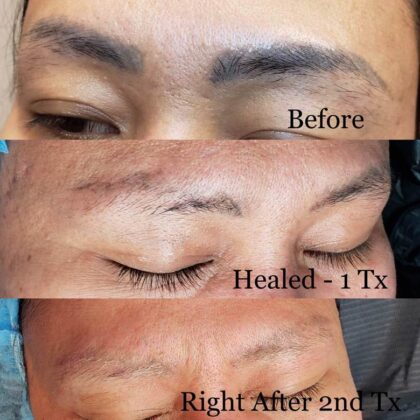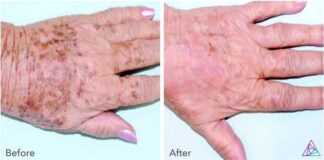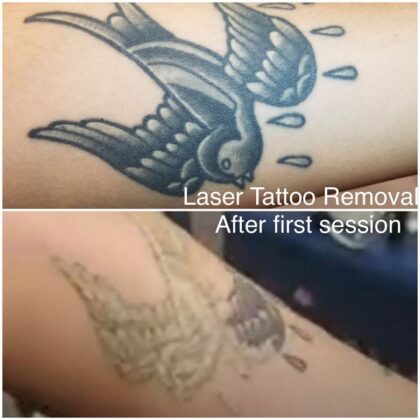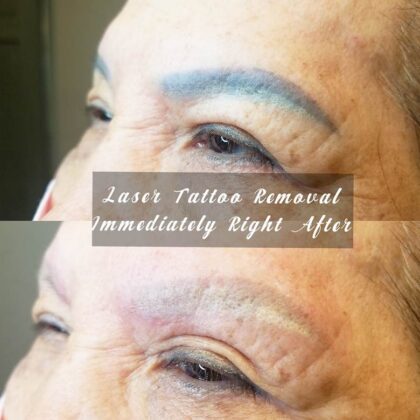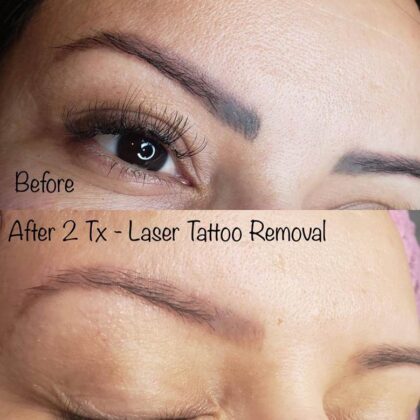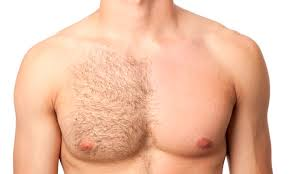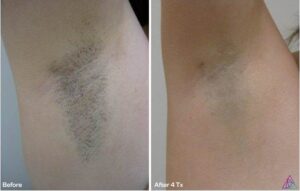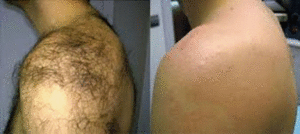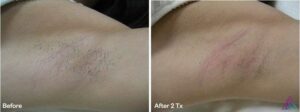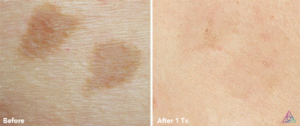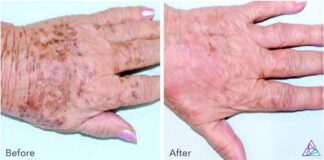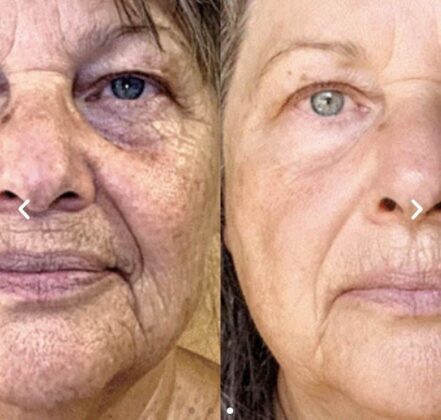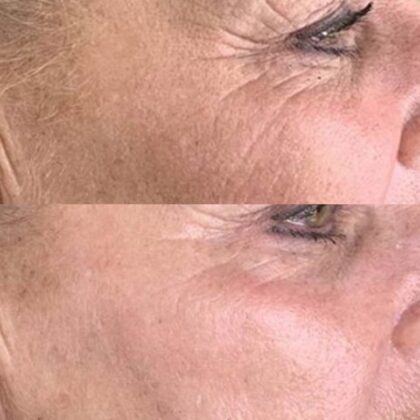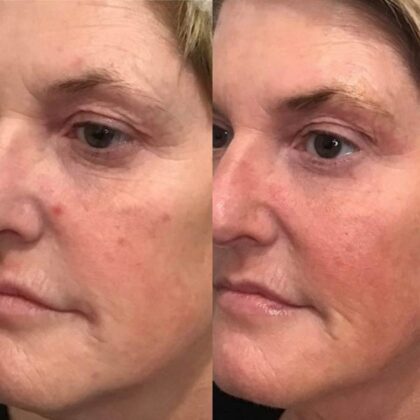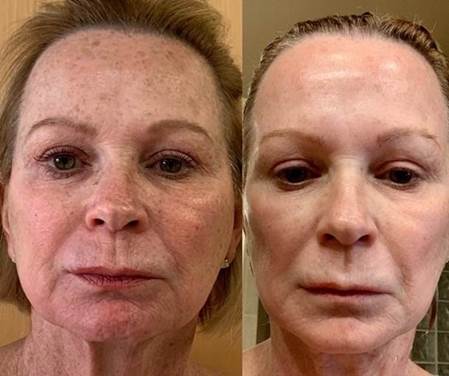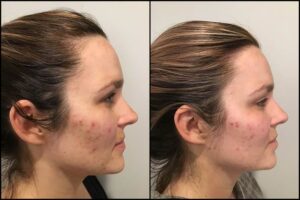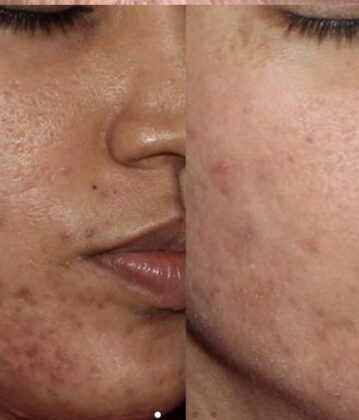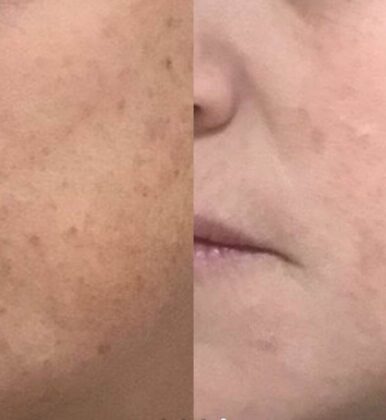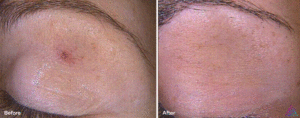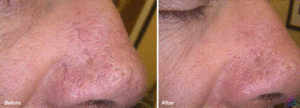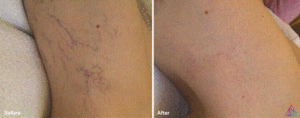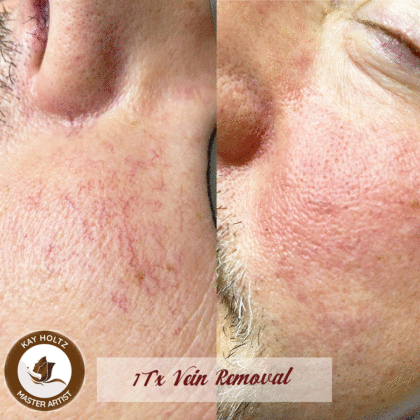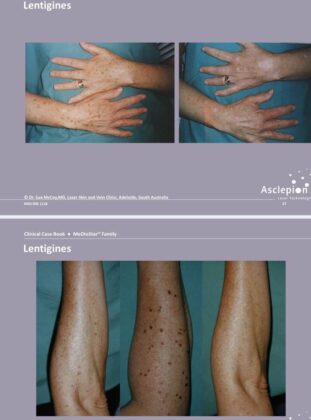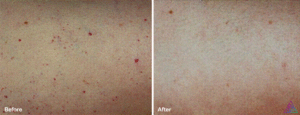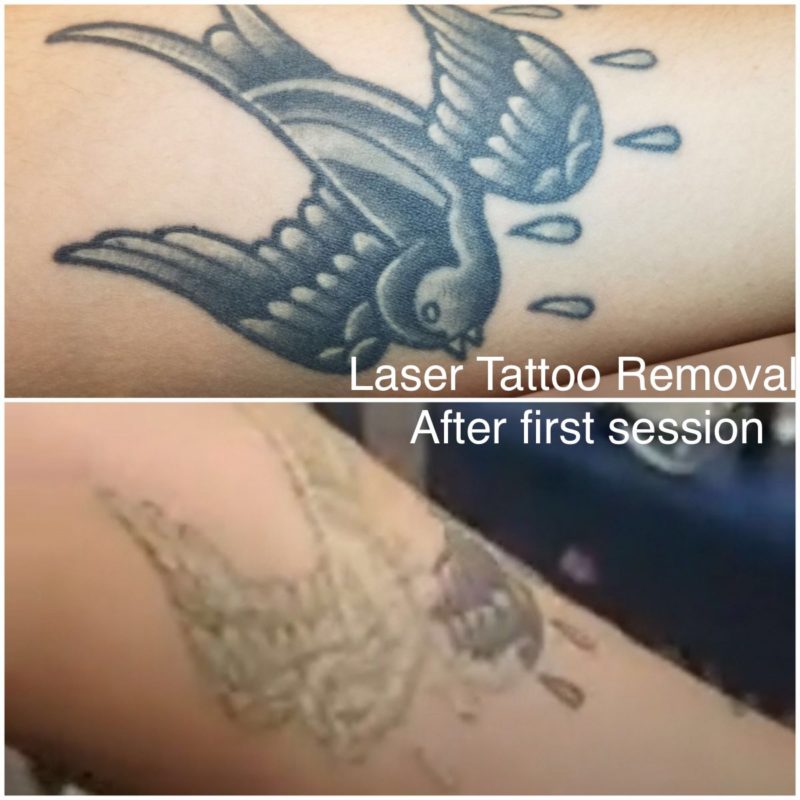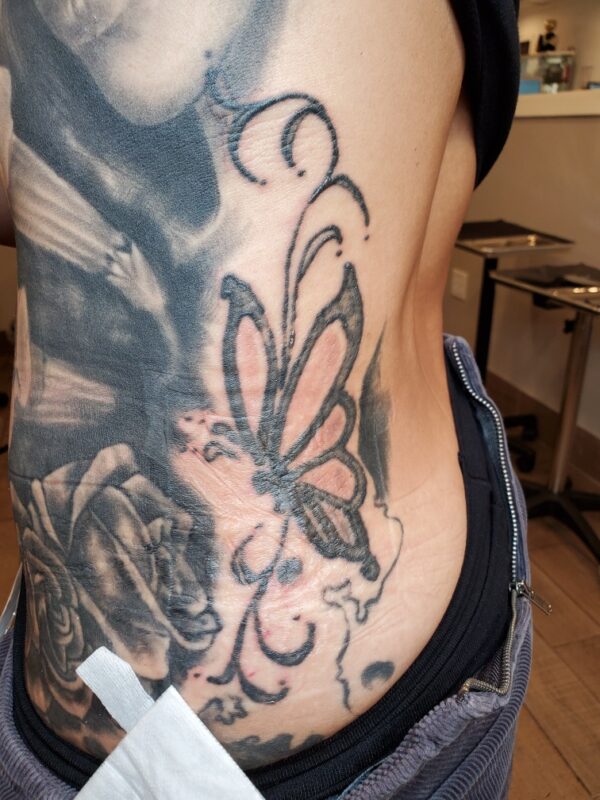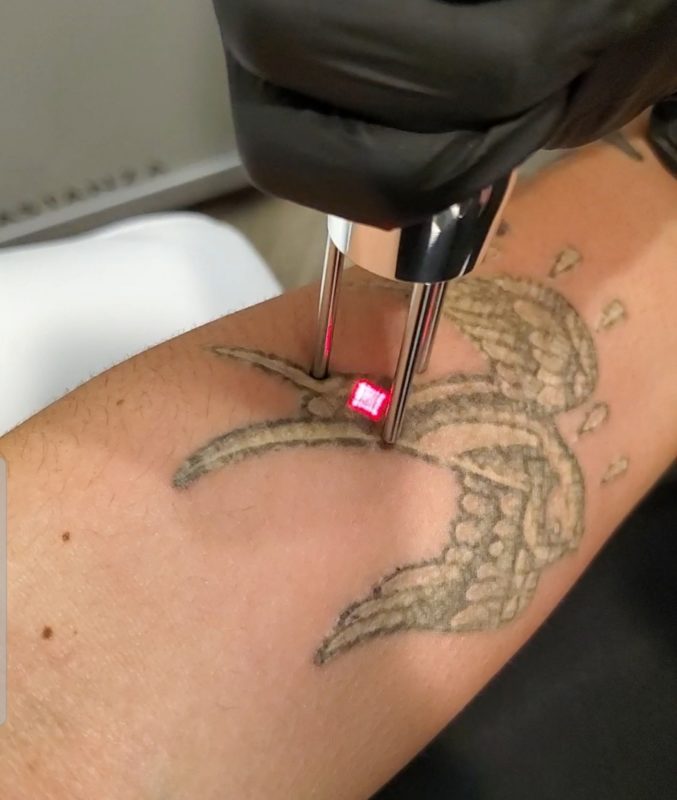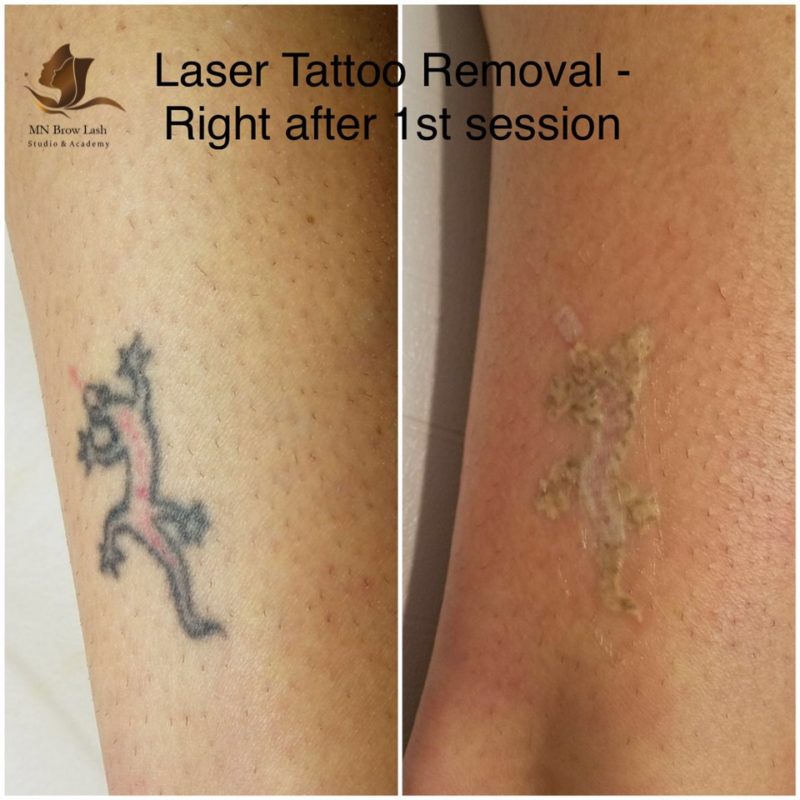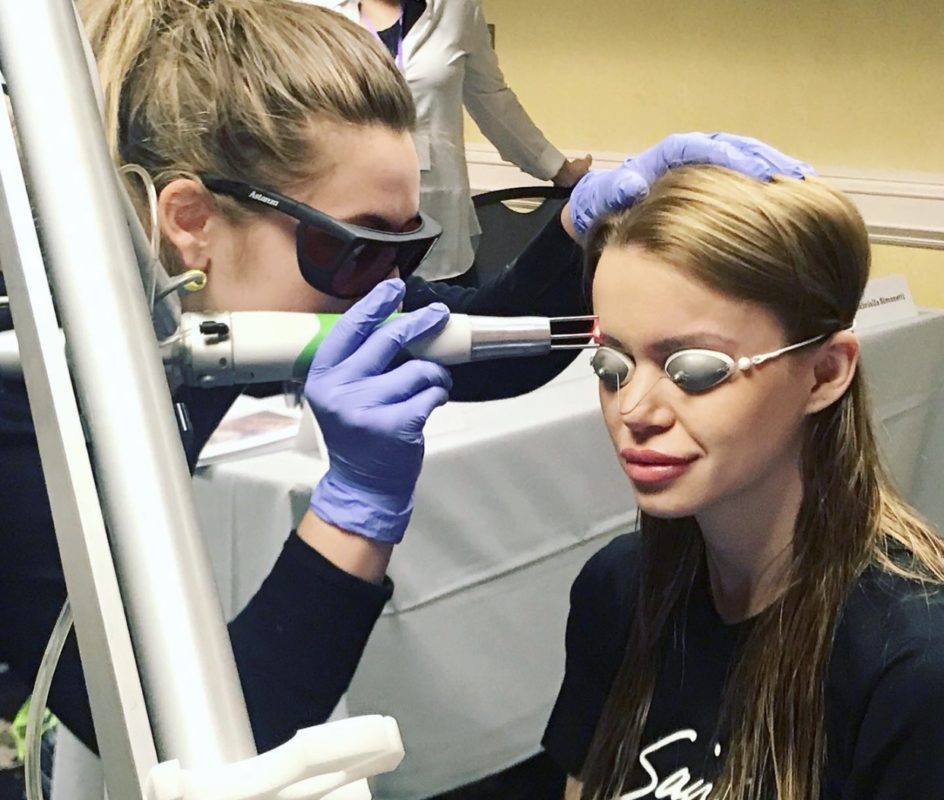Laser Tattoo Removal
Laser tattoo removal is the only clinically-proven method of removing a tattoo without causing scarring. For more than a decade, Q-switched lasers, like those manufactured by Astanza, have been designed to create ultra-short pulses of light energy that shatter ink in a tattoo.
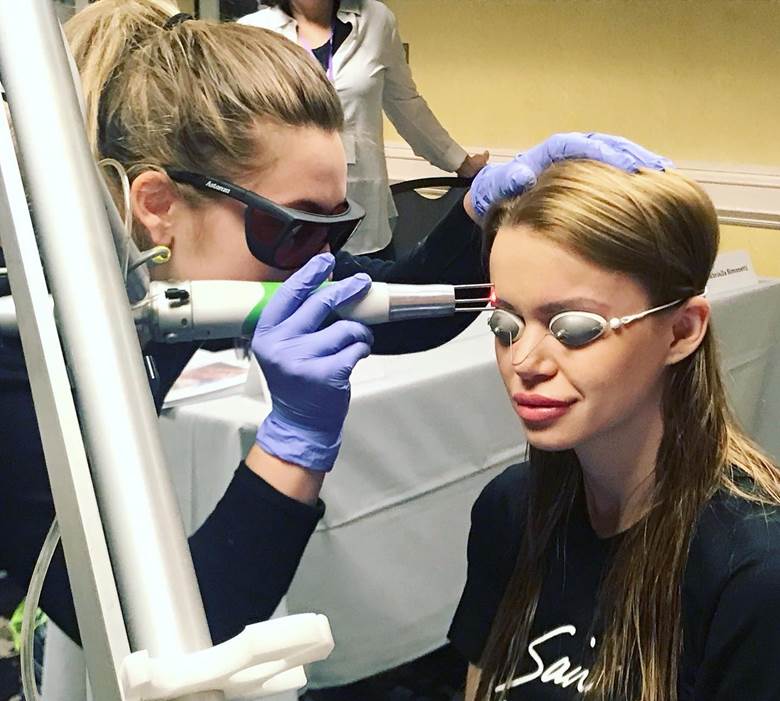
Eyebrows Removal: $250/session
XSmall Area Removal: $90/session
Small Area Removal (2:2, small business card area): $145/session
Medium Area Removal: $250/session
Large area Removal: Consultation Required
Package of 3: 20% off
Package of 5: 25% off
Have a question about laser tattoo removal, check our FAQ
Before & After Result
When tattoo ink is embedded in your skin, the needle puncture creates a small wound that immediately triggers your immune system to heal the tattoo site and remove the alien ink particles. Bacteria eating cells called macrophages are released and begin eating away at the ink particles. However, the pigment particles in tattoo ink are quite large, making it difficult for macrophages to completely remove a tattoo. Instead, the macrophages are only able to remove tiny pieces of pigment, which explains why tattoos are permanent but gradually fade over time.
Laser tattoo removal essentially speeds up your immune system’s natural fading process by shattering the pigment particles in a tattoo. During a laser treatment, our Duality laser sends ultra-quick pulses of light energy over the unwanted tattoo. The light energy travels through the epidermis and targets the tattoo ink particles while leaving the surrounding skin tissue unharmed. The tattoo ink particles selectively absorb the light energy, causing them to heat up and shatter into tiny fragmented particles that the macrophages can more easily engulf and remove.
Over the weeks following a laser treatment, your immune system will flush out the shattered ink particles, causing the tattoo to fade. Multiple laser sessions are needed to shatter the varying layers of ink that make a tattoo. Each session with the laser shatters more ink, speeding up the fading process until no ink is visible in the skin.
Laser tattoo removal assists your body’s natural immune process to remove tattoo ink from your skin. During a laser treatment, light energy is selectively absorbed by a tattoo’s ink particles, causing them to shatter into tiny fragments. Over the weeks following a treatment, your immune system naturally flushes out the fragmented particles, causing your tattoo to fade. This process is repeated until all of the ink in your skin is completely erased.
On average, most patients require 5 to 10 treatments for complete tattoo removal. Patients with older, faded tattoos may need fewer sessions. Patients interested in fading their tattoo for a cover-up tattoo may require as few as 2 to 4 treatments. The number of treatments needed varies case-by-case and depends on a variety of factors including the age of the tattoo, colors of the tattoo, location of the tattoo, the density of the ink, patient health, pre-existing scarring, and more.
Laser tattoo removal is often compared to a rubber band repeatedly snapping the skin. Overall the procedure is very tolerable, however, some patients may experience discomfort depending on their pain threshold. Minnesota Brow offers skin numbing solutions to alleviate any pain from the laser and maximize patient comfort.
Unlike tattoo application, laser tattoo removal is a very quick procedure that lasts anywhere from 1 to 15 minutes depending on the size of the tattoo being treated. Treatment times may take longer if multiple tattoos are being treated in a single session
Laser tattoo removal is the safest method for removing unwanted tattoos. Minnesota Brow uses the latest FDA-cleared laser technology and custom protocols for each patient skin type to ensure the safest, most optimal results.
That being said, patients may experience temporary redness, itchiness, swelling, scabbing, blistering, hypopigmentation, and hyperpigmentation. All of these side effects are natural reactions to the laser and will heal over the weeks following treatment. As long as proper aftercare is applied, patients should not experience any scarring.
The tattoo removal laser treatment may create a superficial burn wound. There is immediate whitening, swelling, and redness of the treated area, which usually lasts for several minutes. Some clients may then develop blisters, crusts, or scabs within 8-72 hours, which can last for 1-2 weeks or more. The treated areas may be pink or pale after the scab separates. Some patients may experience bruising or swelling, which usually fades over the first week after treatment. Scarring, which can be hypertrophic or keloid in nature, may occur but are very rare. Pigmentation abnormalities can occur, but are temporary except in very rare cases. Primary healing is usually complete within 4 weeks, although this may differ depending on several variables. Continued fading can be seen in the following months. A few things to keep in mind to ensure the best possible fading and removal outcome:
- Keep the treated area clean and dry while it is healing. Clean the area gently with soap and water and then pat the area dry. You may apply a thin coating of ointment (i.e. Aquaphor, Petrolatum, Neosporin) up to three times a day for three days while the area is healing. Keep the area covered with a sterile dressing in that time.
- Blisters are possible and likely to occur within the first 8 hours after treatment. Don’t be alarmed, as well cared for blisters heal very well and are part of the normal healing process. Should the blister become cumbersome, use a sterile needle to pop and drain the area, being sure to apply ointment and a bandage after doing so. Continue to put antibiotic ointment over the blisters once they have been popped until the skin is fully healed.
- In the first few hours, the treated area may feel similar to a sunburn. Applying cool compresses can help ease some of the discomfort and inflammation from the treatment.
- Should you scab, don’t pick or expose the scabbed area, as it may result in infection, scarring, or permanent pigment change. Shaving should be avoided in the treated area until it is completely healed.
- It is ok to shower after the treatment, but take care to avoid high pressure water hitting the treated area. Baths, hot tubs, swimming pools, or any form of soaking are not recommended until all blistering and scabbing are completely healed as they may increase the risk of infection.
- Exercise is generally safe after treatment taking into account the other after care instructions provided here. Some bruising may be experienced if muscles underneath the treated area are exercised.
- Wear a sun block SPF of 25 or higher, protecting against UVA/UVB rays over the area for the full time between sessions while removal is performed. Limiting sun exposure between treatments will reduce the amount of tan in the area, thereby reducing the risk of side effects. Do not wear makeup or any cream on the treated area unless recommended by our office for 48 hours.
- Itching is common due to the dehydrating effect of the laser treatment. Use Aquaphor, vitamin E ointment, or hydrocortisone cream to the treatment area. Itching resulting from an allergic reaction is rare, but also possible. Notify us if itching or swelling persists for more than a week after treatment.
- If the area looks infected (honey colored crusting and oozing or spreading redness), if you experience an unusual discomfort or bleeding, if any other complications develop, or if you have any questions or concerns, contact the office immediately.
- Of course, if you have any extreme reaction, call 911 or go to the emergency room.
Laser Hair Removal
Laser hair removal is one of the most common non-surgical aesthetic procedures for both women and men, regardless of the patient’s age or desired treatment area. This lasting trend has grown into a multibillion dollar industry worldwide, with no signs of demand slowing down.
To meet the rising demand of laser hair removal patients, practitioners have adopted light therapy as the most effective method to permanently and efficiently reduce hair growth.
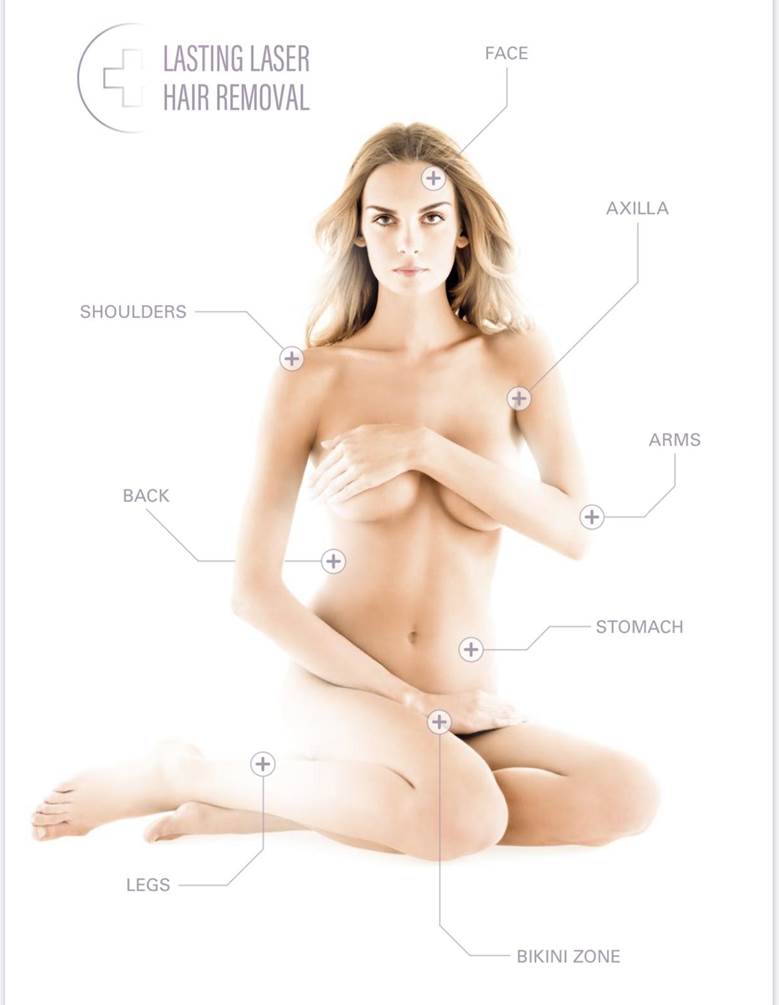
Small Area: $95
Areola, Brows, Cheeks, Chin, Ears, Feet, Hands, Happy Trail, Knuckles, Nose, Sideburns, Toes, Upper Lip
Medium Area: $195
Back Neck, Bikini Line, Breasts, Buttocks, Front Neck, Full Face, Lower Arms, Lower Back, Shoulders, Underarms, Upper Arms
Large Area: $245
Abdomen, Brazilian, Chest, Full Arms, Lower Back, Lower Legs, Upper Back, Upper Legs
X Large Area: $375
Full Back, Full Torso, Full Legs
Have a question about laser Hair removal, check our FAQ
Before & After Result
Depending upon skin type and the area of the body, but typically on average 8-12 sessions for the facial area and 5-8 for the body areas. Each session is about 4-6 weeks apart.
Facial areas are typically 3-6 weeks and Body areas are typically 5-8 weeks depending upon your skin type and your body’s natural hair growth cycle timing
Before the procedure, our technician will clean the treatment area. If the area is particularly sensitive, numbing gel can be applied. During the procedure, everyone in the room needs to wear special protective eyewear to prevent eye damage from the laser.
Once the numbing gel kicks in, the medical specialist focuses a beam of high-energy light at the desired area. The bigger the area you would like treated, the longer the procedure takes. Small areas can take as little as a couple of minutes while larger areas such as the chest can take an hour or more.
Some patients report a sensation like a rubber band snapping or a sunburn-like sting. As the hair vaporizes from the energy of the laser, there can be a sulfurous smell from the smoke puffs.
You may also notice slight redness and swelling at the treated area. Still, these effects are minor. They are often the same effects you might notice after other types of hair removal, such as waxing. Overall, irritation should disappear within hours of the procedure. After laser treatment, you may notice slightly darker or lighter skin. If you have light skin, you’re more likely to have darker spots from laser hair removal.
The opposite is true of people with dark skin, who may have lighter spots from the procedure. However, like skin irritation, these changes are temporary and aren’t usually a cause for concern.
- Pregnant or breastfeeding
- Ages of puberty
- Pre-existing sensitivity to light
- Cellulite therapy in the treatment area (wait two weeks)
- Cancerous lesions in the treatment area
- Haired nevi in the treatment area
- History of Keloid scarring
- Tattoo pigment present in the treatment area
- No treatment around the soft portions of eyes
- No waxing at least 3 weeks before the treatment
- Take a before picture
- Shave the treated area down to the skin (no longer than 1mm)
- Wear comfortable clothes
- During the treatment period, waxing/ tweezing are not allowed. They will ruin the hair growth cycle
- Immediately after treatment, cool the skin
- For the first week after treatment or until local redness fades, avoid:
- Exposure to the sun (apply sunscreen after treatment)
- Exfoliation
- Aggressive scrubbing
- Shaving
- Waxing
- Swimming/Hot Tubs
- Excessive exercise
Photo Facial & Skin Rejuvenation
Treating acne, sun damage, and naturally occurring pigmentation are some of the most common procedures with regards to improving complexion and overall appearance of the skin. Chemical peels and topical treatments were thought to be the best available solution until laser and infrared technology pushed the boundaries, yielding lasting, more impressive results.
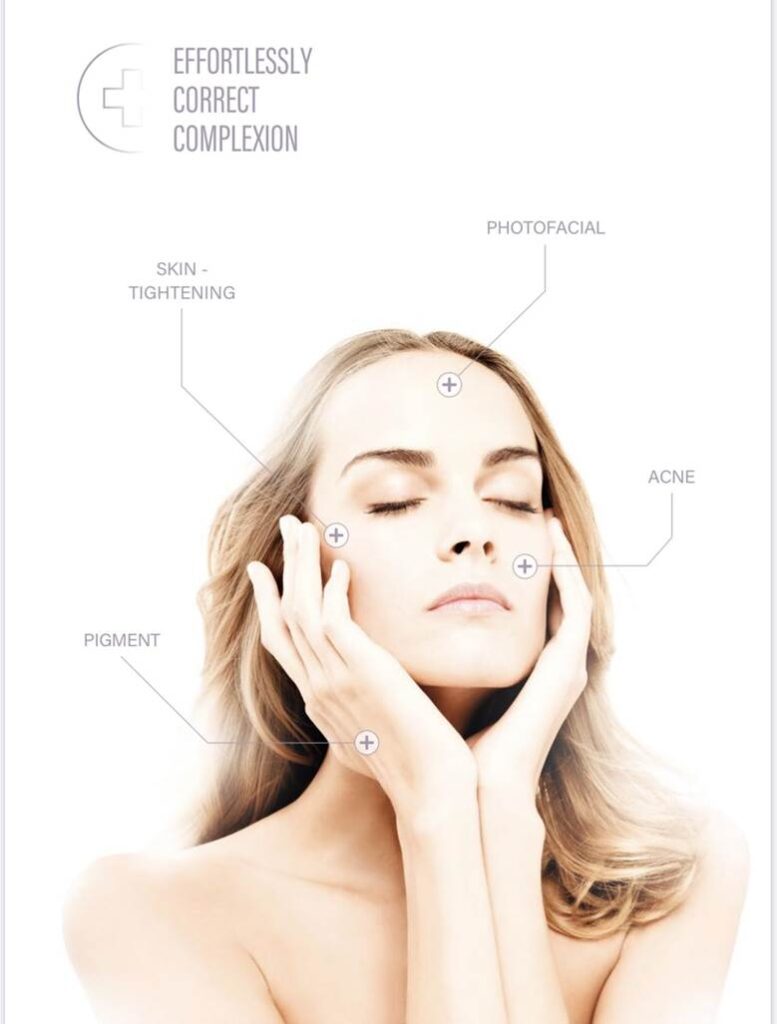
Skin Rejuvenation/Photo Facial: $350/session
Dark Spot: $275/session
Vein Removal: $250/session
Package of 3: 20% off
Package of 5: 25% off
Have a question about Photo Facial & Skin Rejuvenation, check our FAQ
The Hollywood Laser Peel is a gentler version of many other laser treatments. It’s safe for all skin types, can be performed any time of the year, and doesn’t have the long downtime some laser procedures require. It’s designed to help rejuvenate your appearance by diminishing the signs of aging or damaged skin. The treatment provides immediate glow and shine for the skin.
- Feel like sunburn but no downtime
- Safe for all skin types
- No pain or extreme sensation
- Reduces acne scars and hyperpigmentation
- Evens out skin tone
- Improves skin texture
- Smoother, softer and healthier skin
- Improves appearance of fine lines
- Youthful, glowing, radiant-looking skin
How does it work? First, a layer of caron base cream is applied to your skin. Once the cream is set, a laser is used to treat the your skin. The treatment will break up the pigmentation in the skin, allowing it to be naturally removed by the body and acoustically heat the skin, triggering the production of collagen.
Dark Spot Removal/ Skin Photo Facial/ Skin Rejuvenation FAQ
ADVATX BRIGHT: The combination of high powered yellow and infrared laser energy to improve skin tone, texture and overall dermal health by targeting the vascular components of melasma, dyschromia, sun damage and unwanted pigment while simultaneously reducing wrinkles, limiting oil production and shrinking pore size.
ADVATX Clear: Combining pure yellow and high-powered infrared laser energy to eliminate rosacea, acne, acne scars and undesired vascular abnormalities such as telangiectasia, hemangiomas and venous lakes, restoring the skin to a more youthful and healthy state
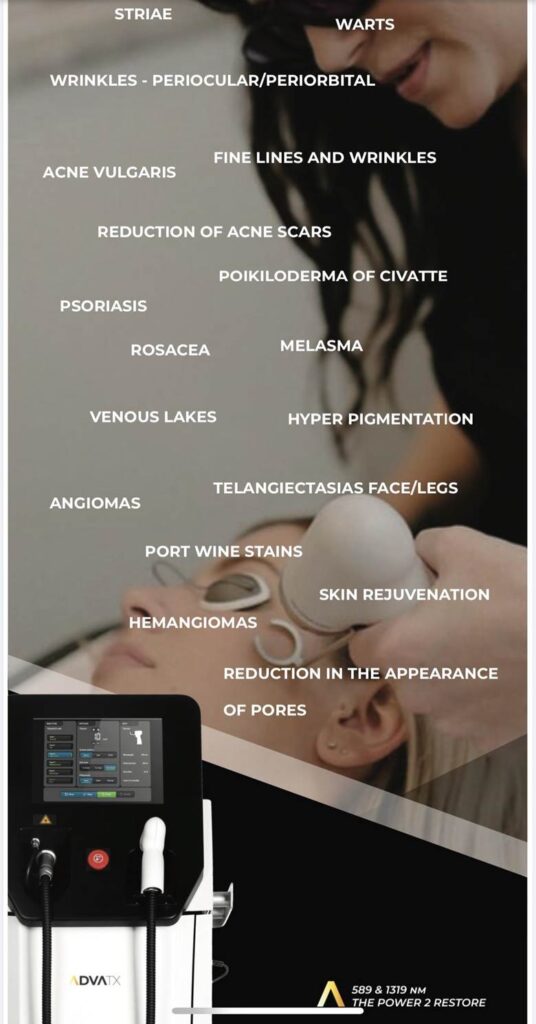 During a skin rejuvenation treatment, our laser emits light over the desired treatment area. The light energy inflicts controlled dermal damage which leads to subsequent collagen remodeling while preserving the skin’s epidermis. The treatment leads to regeneration of the skin structure, tightening of the skin, a reduction in pore size, brightening of pigmentation, and a reduction of small wrinkles.
During a skin rejuvenation treatment, our laser emits light over the desired treatment area. The light energy inflicts controlled dermal damage which leads to subsequent collagen remodeling while preserving the skin’s epidermis. The treatment leads to regeneration of the skin structure, tightening of the skin, a reduction in pore size, brightening of pigmentation, and a reduction of small wrinkles.
Patients may experience light warming and a slight prick, especially over areas with pigmentation. However, the treatment is well-tolerated by most patients and generally does not require any anesthesia or numbing.
Patients should wait a minimum of 4-6 weeks between each laser treatment.
For optimal results, patients should receive 2 to 6 treatments or as new lines or spots recur. Receiving a treatment every 3 months or so is a good maintenance interval, however, many spots, fine lines, and other blemishes will see significant improvement after a single treatment or two.
Ensure the treatment area is clean and that all cosmetic products or tanners are removed an hour or so before treatment. If makeup or tanner is removed immediately before treatment, the skin may appear more red than it’s natural tone. To ensure the best results, the targeted area must be as “normal” as possible.
Avoid excessive sun exposure and tanning activities and wear sunscreen daily.
Patients can cool the skin after treatment with a cold compress for as long as desired. If crusts form, allow them to heal naturally. Do not interfere with any scabbing; doing so can lead to infection and unwanted side effects. Apply sunscreen daily and avoid excessive sun exposure or tanning activities
IMPORTANT! Avoid sun exposure and tanning beds to the treated area. Once the scabbing process is complete, ALWAYS apply broad spectrum SPF 50 or higher to the area for a minimum of 3 months following your last treatment. This skin is still healing and can EASILY become damaged by any UV rays and may cause hyperpigmentation and/or premature aging.
- Taking collagen, vitamin C and L-lysine supplements over the course of your healing process can give your immune system and collagen production a boost.
- Avoid smoking.
- Do not use AHA’s, BHA’s, Retin-A or Renova for 72 hours following treatment.
- Avoid direct sunlight for 72 hours following treatment.
- Wash treated are morning and night with cleanser.
- If redness or sensitivity occurs, wash treated area and apply a cool compress or ice pack. If sensitivity continues for more than 12 hours, contact your physician or skincare provider.
- Avoid shaving over any treated area until skin has fully healed.
- Avoid exercise for 24 hours following treatment. Heat, steam or sweat can add to inflammation.
- Do not use any pools, hot tubs or saunas until your skin returns to a more normal state.
- If you are prone to cold-sores, the treatment may cause a breakout, ask your doctor for a prophylactic treatment such as Valtrex (5 days prior and 5 days after are optimal).
- Do not peel or pick at loose skin or crusting. This may result in SEVERE scarring and discoloration to affected area. If crusting occurs, apply petroleum jelly to the affected area until healed.
- Keep skin well hydrated with appropriate moisturizer.
- Do not use anything harsh on your skin (like acids, peels or physical exfoliants) until you have reached 8 weeks post treatment.
Before & After Result
Vein Lesion Removal FAQ
During a vascular lesion treatment, our MeDioStar laser sends a light beam into the skin and targets the hemoglobin of the blood found in the vein or vessel. The blood vessel absorbs the light energy, heats up, and becomes inflamed or swollen. This reaction leads to the occlusion or collapse of the vessel, which successfully cuts off the blood flow without harming the surrounding skin tissue.
Immediately after treatment, patients may experience temporary redness and swelling. Over the weeks following a treatment, your vascular lesion may leave a small bruise or transient pigment changes. Both of these side effects will heal naturally over time and reveal blemish-free skin. Vasculature treatments, including the erythema associated with acne, should produce improvement after a treatment or two.
Patients may experience a small prick that is associated with a heat sensation. The severity of this sensation depends on the thickness of the vessel being treated. The duration of the treatment depends on the size of the vascular lesion, however, most treatments only take a few minutes.
On average, the majority of patients will see significant results after just one treatment. A second or third treatment may be required depending on the size of the vessel. Larger veins may need additional treatments because they’re more stubborn.
Patients must wait generally 2 to 3 months between treatments. However, most patients may only require one treatment whereas others will see strong improvement after a treatment or two.
Shave the day before treatment. Ensure the treatment area is clean and remove any cosmetic products or tanners an hour or so before treatment. If makeup or tanner is removed immediately before treatment, the skin may appear more red than it’s natural tone. To ensure the best results, the targeted area must be as “normal” as possible.
Apply a cold compress if there is lingering heat. Avoid the sun and apply sunscreen daily.
Pigmented lesions, also referred to as sun spots, age spots, or brown spots, are common cosmetic blemishes that form with age and excessive sun exposure. There are many different types of pigmented lesions, including melanomas. Before receiving laser treatment, it is recommended that you receive an evaluation from a dermatologist or physician to confirm that your lesions are benign.
During a treatment, our laser penetrates through the epidermis and targets the melanin in the unwanted pigmented lesion. The skin cells that contain excess melanin and pigment absorb the laser’s energy, heat up, and are broken down. The broken down pigment is then naturally removed by the body’s lymphatic system.
Patients may experience a warm sensation or light prick of the skin. After a few hours, the treated lesions may darken and a small crust may form. These side effects will heal over days following treatment.
Most patients see complete removal after 1 to 2 treatments. However, freckles and sun spots frequently appear with sun exposure, so ongoing treatment may be required to maintain the clearest complexion.
Patients should wait 6 to 8 weeks between treatments.
Ensure the treatment area is clean and that all cosmetic products or tanners are removed an hour or so before treatment. If makeup or tanner is removed immediately before treatment, the skin may appear more red than it’s natural tone. To ensure the best results, the targeted area must be as “normal” as possible.
Patients can cool the skin after treatment with a cold compress for as long as desired. If crusts form, allow them to heal naturally. Do not interfere with any scabbing; doing so can lead to infection and unwanted side effects. Apply sunscreen daily and avoid excessive sun exposure or tanning activities.
IMPORTANT! Avoid sun exposure and tanning beds to the treated area. Once the scabbing process is complete, ALWAYS apply broad spectrum SPF 50 or higher to the area for a minimum of 3 months following your last treatment. This skin is still healing and can EASILY become damaged by any UV rays and may cause hyperpigmentation and/or premature aging.
- Taking collagen, vitamin C and L-lysine supplements over the course of your healing process can give your immune system and collagen production a boost.
- Avoid smoking.
- Do not use AHA’s, BHA’s, Retin-A or Renova for 72 hours following treatment.
- Avoid direct sunlight for 72 hours following treatment.
- Wash treated are morning and night with cleanser.
- If redness or sensitivity occurs, wash treated area and apply a cool compress or ice pack. If sensitivity continues for more than 12 hours, contact your physician or skincare provider.
- Avoid shaving over any treated area until skin has fully healed.
- Avoid exercise for 24 hours following treatment. Heat, steam or sweat can add to inflammation.
- Do not use any pools, hot tubs or saunas until your skin returns to a more normal state.
- If you are prone to cold-sores, the treatment may cause a breakout, ask your doctor for a prophylactic treatment such as Valtrex (5 days prior and 5 days after are optimal).
- Do not peel or pick at loose skin or crusting. This may result in SEVERE scarring and discoloration to affected area. If crusting occurs, apply petroleum jelly to the affected area until healed.
- Keep skin well hydrated with appropriate moisturizer.
- Do not use anything harsh on your skin (like acids, peels or physical exfoliants) until you have reached 8 weeks post treatment.
Before & After Result
Book Now
The Science Behind the Results
Laser tattoo removal is the only clinically-proven method of removing a tattoo without causing scarring. For more than a decade, Q-switched lasers, like those manufactured by Astanza, have been designed to create ultra-short pulses of light energy that shatter ink in a tattoo.The production of ultra-short (nanosecond) pulses of the precise wavelengths of light energy best designed to shatter tattoo ink is the hallmark of Astanza’s technology. No other manufacturer has made the same commitment to this precise field of lasers, and practitioners worldwide demand the power and reliability of Astanza’s superior Q-switched lasers.
Laser-Skin Interaction
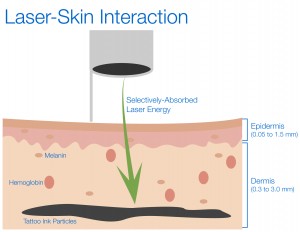 During a tattoo removal procedure, laser light is applied to the tattooed area of the skin. The light is selectively absorbed by the tattoo ink particles, leaving the surrounding skin tissue and chromophores unharmed.The tattoo ink particles absorb the laser energy, heat up, and shatter into smaller ink particles.In the days and weeks following a laser treatment, the body’s immune system flushes away the shattered ink particles, causing the tattoo to fade. Over a series of treatments, more and more of the ink shatters, leaving the skin free of ink.
During a tattoo removal procedure, laser light is applied to the tattooed area of the skin. The light is selectively absorbed by the tattoo ink particles, leaving the surrounding skin tissue and chromophores unharmed.The tattoo ink particles absorb the laser energy, heat up, and shatter into smaller ink particles.In the days and weeks following a laser treatment, the body’s immune system flushes away the shattered ink particles, causing the tattoo to fade. Over a series of treatments, more and more of the ink shatters, leaving the skin free of ink.
Laser Tattoo Removal Results
Before & After Photos from Real Patients
The photos below show tattoos removed with Astanza laser technology. They are typical styles of tattoos that Astanza practitioners produce in their tattoo removal practices every day. As illustrated below, Astanza lasers can effectively remove a variety of tattoo colors to completion on the widest, full range of skin types.

